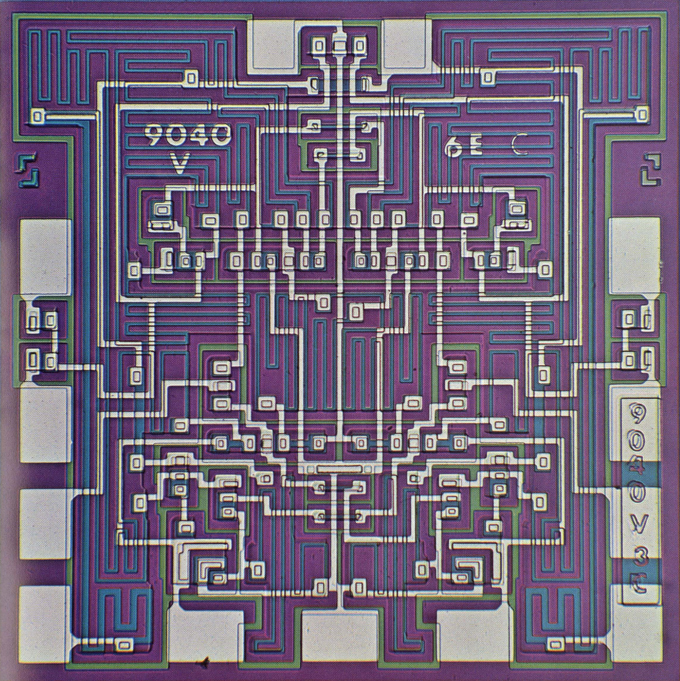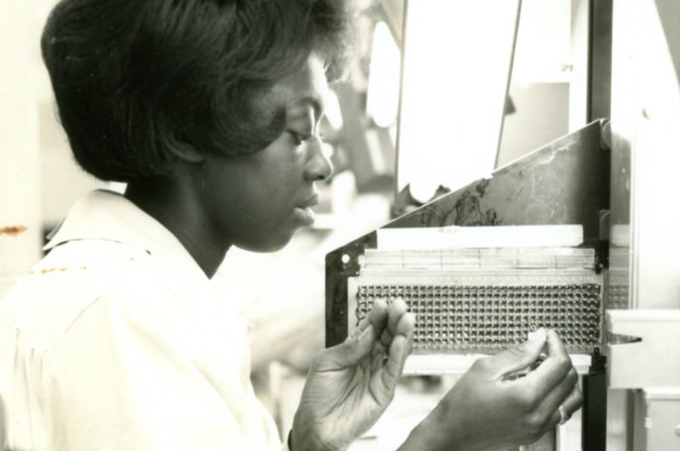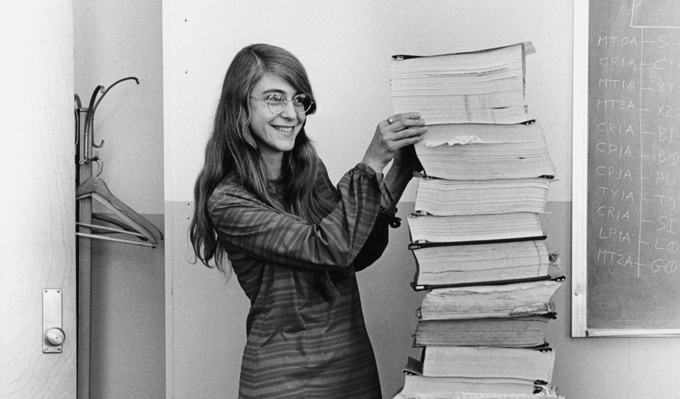The historic Apollo moon missions are often associated with high-visibility test flights, dazzling launches and spectacular feats of engineering. But intricate, challenging handiwork — comparable to weaving — was just as essential to putting men on the moon. Beyond Neil Armstrong, Buzz Aldrin and a handful of other names that we remember were hundreds of thousands of men and women who contributed to Apollo over a decade. Among them: the Navajo women who assembled state-of-the-art integrated circuits for the Apollo Guidance Computer and the women employees of Raytheon who wove the computer’s core memory.
In 1962, when President John F. Kennedy declared that putting Americans on the moon should be the top priority for NASA, computers were large mainframes; they occupied entire rooms. And so one of the most daunting yet crucial challenges was developing a highly stable, reliable and portable computer to control and navigate the spacecraft.

To celebrate our 100th anniversary, we’re highlighting some of the biggest advances in science over the last century. To see more from the series, visit Century of Science.
ReAD MORE
NASA chose to use cutting-edge integrated circuits in the Apollo Guidance Computer. These commercial circuits had been introduced only recently. Also known as microchips, they were revolutionizing electronics and computing, contributing to the gradual miniaturization of computers from mainframes to today’s smartphones. NASA sourced the circuits from the original Silicon Valley start-up, Fairchild Semiconductor. Fairchild was also leading the way in the practice known as outsourcing; the company opened a factory in Hong Kong in the early 1960s, which by 1966 employed 5,000 people, compared with Fairchild’s 3,000 California employees.
At the same time, Fairchild sought low-cost labor within the United States. Lured by tax incentives and the promise of a labor force with almost no other employment options, Fairchild opened a plant in Shiprock, N.M., within the Navajo reservation, in 1965. The Fairchild factory operated until 1975 and employed more than 1,000 individuals at its peak, most of them Navajo women manufacturing integrated circuits.
It was challenging work. Electrical components had to be placed on tiny chips made of a semiconductor such as silicon and connected by wires in precise locations, creating complex and varying patterns of lines and geometric shapes. The Navajo women’s work “was performed using a microscope and required painstaking attention to detail, excellent eyesight, high standards of quality and intense focus,” writes digital media scholar Lisa Nakamura.
 A brochure commemorating the dedication of Fairchild Semiconductor’s plant in Shiprock, N.M., included this Fairchild 9040 integrated circuit.Courtesy of the Computer History Museum
A brochure commemorating the dedication of Fairchild Semiconductor’s plant in Shiprock, N.M., included this Fairchild 9040 integrated circuit.Courtesy of the Computer History Museum
In a brochure commemorating the dedication of the Shiprock plant, Fairchild directly compared the assembly of integrated circuits with what the company portrayed as the traditional, feminine, Indigenous craft of rug-weaving. The Shiprock brochure juxtaposed a photo of a microchip with one of a geometric-patterned rug, and another of a woman weaving such a rug. That portrayal, Nakamura argues, reinforced racial and gender stereotypes. The work was dismissed as “women’s work,” depriving the Navajo women of appropriate recognition and commensurate compensation. Journalists and Fairchild employees also “depict[ed] electronics manufacture as a high-tech version of blanket weaving performed by willing and skillful Indigenous women,” Nakamura notes, yet “the women who performed this labor did so for the same reason that women have performed factory labor for centuries — to survive.”
Far from the Shiprock desert, outside of Boston, women employees at Raytheon assembled the Apollo Guidance Computer’s core memory with a process that in this case directly mimicked weaving. Again, the moon missions demanded a stable and compact way of storing Apollo’s computing instructions. Core memory used metal wires threaded through tiny doughnut-shaped ferrite rings, or “cores,” to represent 1s and 0s. All of this core memory was woven by hand, with women sitting on opposite sides of a panel passing a wire-threaded needle back and forth to create a particular pattern. (In some cases, a woman worked alone, passing the needle through the panel to herself.)
 Women employees of Raytheon assembled core memory for the Apollo Guidance Computer by threading metal wires through rings. (This unnamed woman was described as a “space age needleworker” in a Raytheon press kit.)Courtesy of the collection of David Meerman Scott, Raytheon public relations
Women employees of Raytheon assembled core memory for the Apollo Guidance Computer by threading metal wires through rings. (This unnamed woman was described as a “space age needleworker” in a Raytheon press kit.)Courtesy of the collection of David Meerman Scott, Raytheon public relations
Apollo engineers referred to this process of building memory as the “LOL,” or “Little Old Ladies,” method. Yet this work was so mission critical that it was tested and inspected multiple times. Mary Lou Rogers, who worked on Apollo, recalled, “[Each component] had to be looked at by three of four people before it was stamped off. We had a group of inspectors come in for the federal government to check our work all the time.”
The core memory was also known as rope memory, and those who supervised its development were “rope mothers.” We know a great deal about one rope mother — Margaret Hamilton. She has been recognized with the Presidential Medal of Freedom, among other awards, and is now remembered as the woman who oversaw most of the Apollo software. But her efforts were unrecognized by many at the time. Hamilton recalled, “At the beginning, nobody thought software was that big a deal. But then they began to realize how much they were relying on it…. Astronauts‘ lives were at stake. Our software needed to be ultrareliable and it needed to be able to detect an error and recover from it at any time during the mission. And it all had to fit on the hardware.” Yet, little is known about the thousands of others who performed this mission-critical work of weaving integrated circuits and core memory.
 Margaret Hamilton is known for overseeing the development of the Apollo software. Draper Laboratory, restored by Adam Cuerden/Wikimedia Commons
Margaret Hamilton is known for overseeing the development of the Apollo software. Draper Laboratory, restored by Adam Cuerden/Wikimedia Commons
At the time, Fairchild’s representation of the Navajo women’s work as a feminine craft differentiated it from the high-status and masculine work of engineering. As Nakamura has written, the work “came to be understood as affective labor, or a ‘labor of love.’” Similarly, the work performed at Raytheon was described by Eldon Hall, who led the Apollo Guidance Computer’s hardware design, as “tender loving care.” Journalists and even a Raytheon manager presented this work as requiring no thinking and no skill.
Recently, the communications scholar Samantha Shorey, engineer Daniela Rosner, technologist Brock Craft and quilt artist Helen Remick firmly overturned the notion that weaving core memory was a “no-brainer” with their Making Core Memory project. In nine workshops, they invited participants to weave core memory “patches” using metal matrices, beads and conductive threads, showcasing the deep focus and meticulous attention to detail required. The patches were then assembled in an electronic quilt that played aloud accounts from 1960s Apollo engineers and Raytheon managers. The Making Core Memory collaboration challenged the dichotomy of masculine, high-status, well-paid science and engineering cognitive labor versus feminine, low-status, low-paid, manual labor.
A 1975 NASA report that summarized the Apollo missions spoke glowingly of the Apollo computing systems — but mentioned none of the Navajo or Raytheon women. “The performance of the computer was flawless,” the report declared. “Perhaps the most significant accomplishment during Apollo pertaining to guidance, navigation, and control was the demonstration of the versatility and adaptability of the computer software.”
That computer, and that software, relied on the skilled, technical, embodied expertise and labor of thousands of women, including women of color. They were indubitably women of science, and their untold stories call us to reconsider who does science, and what counts as scientific expertise.

